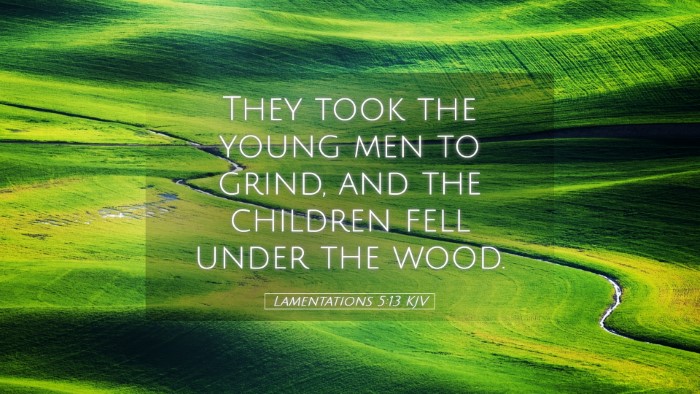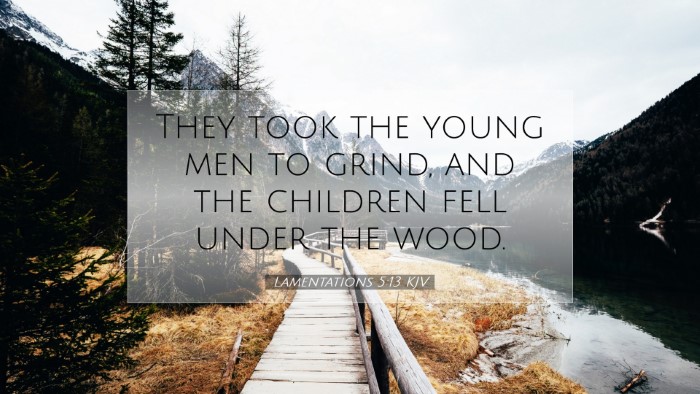Lamentations 5:13 Commentary
Verse: "They took the young men to grind, and the children fell under the wood."
Introduction
The Book of Lamentations, traditionally attributed to the Prophet Jeremiah, articulates profound sorrow over the destruction of Jerusalem. In Lamentations 5:13, the imagery reflects not only the physical suffering but also the social and familial disintegration resulting from the Babylonian exile. This commentary synthesizes insights from various public domain sources, including Matthew Henry, Albert Barnes, and Adam Clarke, to elucidate the theological and historical implications of this verse.
Historical Context
Lamentations is set against the backdrop of Jerusalem's destruction in 586 B.C. The once-thriving city now lies in ruins, and its inhabitants face exile and hardship. This particular verse highlights the consequences of war, as the young men are conscripted for labor—a grave reminder of the community's loss and the exploitation of its vulnerable members.
Matthew Henry's Insights
Henry articulates that this verse illustrates the deep humiliation of the nation. The young men, typically seen as the strength of the community, are reduced to menial tasks such as grinding grain, a job reserved for the least esteemed. This is emblematic of the subjugation they face and symbolizes the loss of dignity and purpose among God’s chosen people.
Albert Barnes' Analysis
Barnes provides a detailed examination of the phrase "to grind." He notes that grinding grain was a task assigned mostly to women and slaves, indicating a reversal of societal roles. The young men's relegation to this task highlights not only their physical subjugation but also the dismantling of family roles and structures. Barnes concludes that such degradation reflects the broader desolation of society due to sin and rebellion against God.
Adam Clarke's Commentary
Clarke emphasizes the dire consequences of the Babylonian conquest upon the children: "the children fell under the wood." His interpretation suggests a vivid image of the collapse of innocence and the heavy burden the young bear in their communities. The imagery Clarke presents evokes a sense of tragedy—not only have the adult men been oppressed, but the youth suffer from the weight of despair and hardship, falling figuratively under the burdens placed upon them.
Theological Reflections
This verse provides a poignant commentary on suffering and its intergenerational impact. The decay of societal structure is not superficial; it touches upon the heart of God's intended order for family and community. The lament reflects the consequences of sin and the divine judgement that has led to this state of anguish.
Lessons for Ministry
- Understanding Despair: Pastors and theologians can draw on Lamentations 5:13 to empathize with congregants facing profound loss and societal brokenness. Understanding the distractions of servitude is essential for guiding those who feel diminished in their contributions.
- Advocacy for the Young: The plight of the children serves as a call to action for those in ministry. Churches must prioritize support systems for the youth, recognizing that the burdens of despair often weight heavily upon them.
- Restoration through Community: The broader context of Lamentations shows a longing for restoration. Pastoral care should foster hope and a vision for rebuilding, echoing the potential for renewal that God offers to His people.
Conclusion
Lamentations 5:13 is a stark reminder of the devastating effects of national sin and judgement. By examining the implications through the lenses of Henry, Barnes, and Clarke, scholars and theologians glean insights into the socio-theological landscape of the time, which remains relevant today. As faithful readers of the text, we are urged to confront both the reality of sin's consequences and the hope embedded in the truths of restoration through God's mercy.


